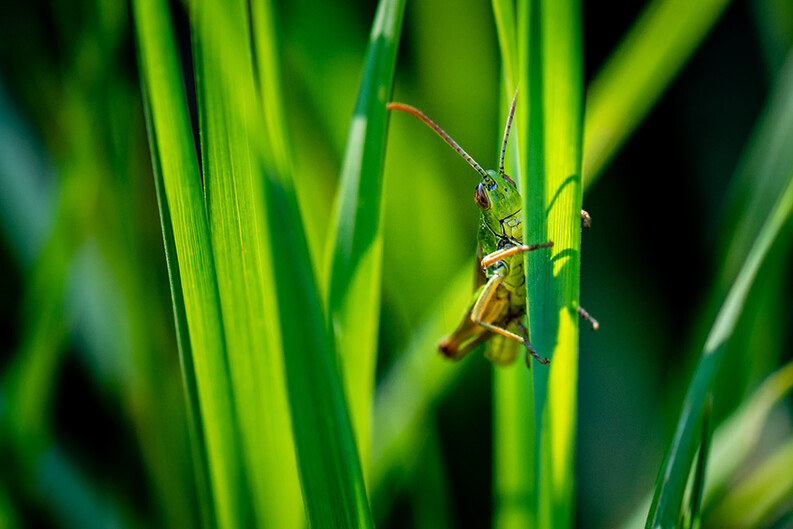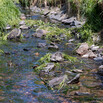Q&A: Nathalie Sommer on How Differences in Grasshopper Personality Affect Ecosystems

Nathalie Sommer is a Law, Ethics & Animals Program (LEAP) Student Fellow and a Ph.D. candidate at the Yale School of the Environment, where she works in the Schmitz Lab. In 2020, she published “Differences in prey personality mediate trophic cascades,” in Ecology & Evolution, in which she showed how individual differences in grasshopper personality could cause ecosystem-level changes. She also explores issues at the intersection of conservation and philosophy together with LEAP Student Fellow Kristy Ferraro. LEAP Programs Fellow Noah Macey spoke with Sommer about her research on animal personality and conservation ethics. Their conversation has been edited for clarity.
How did you come to be interested in animal personality?
The research on animal personality, like a lot of my other research, stems from my focus on evolutionary ecology and thinking about the ways that evolution influences ecology on a contemporary timescale. Animal personality was interesting because of an idea called plasticity, essentially when organisms can have the same genotype but express different phenotypes depending on the environment. When it comes to behavior and animals, we usually think of behavior as being purely flexible, such that any individual can express the full suite of behaviors available to the species. What’s interesting about personality is the idea that behavior itself is constrained, so that behavior isn’t purely flexible. And it’s not only that there is a constraint to behavior, but those constraints can be genotypically determined and vary from individual to individual.

A trophic cascade is when you have a predator that exerts a top-down effect that impacts the amount of biomass at the bottom of the food web. Typically, when people look at food webs, they’re thinking about what plants are growing and supporting the herbivores, and then what herbivores are supporting the predators. But the idea of a trophic cascade inverts that direction: how does the predator influence all of the trophic levels beneath it?
I did a series of nested experiments to explore the question of how personality within herbivores could affect overall trophic cascades. I knew that predators in the grasshopper-spider system primarily exert non-consumptive effects, meaning the spiders scare their prey, so I also knew what to expect in terms of a typical trophic cascade in the system. My goal was to constrain the personality types of herbivores experimentally. That involved collecting a bunch of grasshoppers and bringing them into the lab and assaying their personality. I would put the grasshoppers through a series of behavioral tests to see whether or not their behavior was consistent across contexts, and also if the behavior was consistently different among individuals.
From there, I looked at individuals at the extremes of both ends of this personality assay. Individuals at one end of this personality assay were “shy” — they had lower activity levels, froze around predators, wouldn’t forage even after a fasted period, and didn’t move around when I gave them a novel object. Then on the other end, there were “bold” individuals, who were always moving and foraging, and who weren’t fazed by predators.
I took subsets of these shy and bold individuals and put them into the field, using experimental cages called mesocosms, in which you can create a controlled mimic of the real world — there are both plants and predators. I created experimental communities in these cages, half with mini-populations of shy herbivores, and half with bold ones. From there, it was a matter of letting the experiment go for the whole summer and checking the cages at the end. What plants did the different herbivores eat? How many of the herbivores actually survived? Did the type of personality alter the trophic cascade from the predator? Overall, I found a compelling effect for personality — constrained behavior did have an impact on the plant community, and it impacted how the predators were able to influence overall biomass.
I also validated this result by looking at the specific habitat that shy and bold grasshoppers used. Not only do they use different types of vegetation and eat different plants, but they adjust their habitat in response to predation in predictable ways. For example, shy individuals substantially narrowed their foraging range when predators were around, while bold individuals still had a very wide foraging range. This part of my study was particularly novel, because it showed mechanistically how personality translated to classic ecological interactions.
It’s interesting to talk about animal personality on this shy-bold continuum. Do you think there are common personality traits in animals other than risk-aversion that might have an effect on ecology?
I think risk aversion is the go-to right now when it comes to thinking about personality in ecology, only because we do understand so much about risk. Another aspect of personality that might be applicable to ecology is exploration — which, on a broad scale, translates to an individual’s willingness to disperse away from its natal environment. That’s something you can see across taxa, from arthropods to lions: how far is an individual willing to go when it disperses? There are absolutely personality considerations when it comes to social animals, but those are beyond my area of expertise.
One example of a personality effect was that shy grasshoppers ate more grass under predation compared to bold grasshoppers. Could you talk a bit more about what that sort of finding might mean for an ecosystem as a whole?
It comes down to what personality types are present within your population and within your ecosystem. For this particular experiment, I was sampling a big part of the population, and I found a large spread of personality types. So if someone were to go and do ecosystem measurements where there’s already a big spread of personality types, you might find that the effect of personality on ecosystem-level processes comes out in the wash. Essentially, the effects would average out, and they’d find what you might expect if you didn’t take personality into account.
Where it starts to become an important factor is when you have a nonrandom distribution of personality types, or a smaller population — perhaps a population that’s been newly established or segmented by humans in a conservation scenario. In this particular case, the shy grasshoppers under predation were eating grass — an entirely different outcome than the typical one in this system, where the grasshoppers eat goldenrod. And we know that what grasshoppers eat has ecosystem level effects related to decomposition rates, carbon mineralization, and nitrogen mineralization. This particular study points out that personality could be an underlying factor when your ecosystem measurements aren’t giving you what you might predict based on average population effects alone. It calls attention to how individuals have a substantial influence over their ecosystem, and how scientists shouldn’t assume that individual variation can be ignored.
You used insects as a model system. Do you think that this result would hold for other animals like birds and mammals? Is there anything particularly useful in thinking about insects this way?
There is personality research that happens in birds, but most of the foundational studies are in insects, spiders, and fish. The main challenge when it comes to doing personality studies is that you need to be able to track individuals. I know there are people who work at larger scales with large mammals, and they are able to put trackers on individuals — they’re able to think about the ways that individuals differ consistently from one another in terms of movement. So the idea is certainly spreading to other organisms.
I think humans have a tendency to anthropomorphize vertebrates, the fuzzy and cute. It’s a lot easier for humans to relate, so thinking about individuals and their role and value to ecosystems comes more readily with those animals. When it comes to insects, the idea that individuals could differ from one another consistently gives importance to the role of the individual, which can be difficult to grasp simply because there are so many more insect individuals in a single population than there are large and fuzzy mammals. Personality in the ecological sphere isn’t quite the same as personality in the human sphere, but even the idea that individuals can differ in their behavior could potentially lead people to think a little bit more critically about the ways that we treat arthropods. Take institutional review boards. We have IACUC [Institutional Animal Care & Use Committee], and it’s quite strict when it comes to dealing with vertebrates. We think carefully about how we handle vertebrates, usually on the basis of pain. We don’t think very much about how we handle invertebrates at all, which is part of the reason they make for very tractable study systems: there aren’t many rules and regulations about things we’re allowed to do with invertebrates. So, if personality gives people a moment of pause to think, “wait, could invertebrates deserve similar consideration to what we see within our institutions through IACUC?” — that could be an outcome of this research.
You’re interested in conservation ethics and philosophy, and have been working with LEAP Fellow Kristy Ferraro on projects related to those areas. I was wondering if working on this experiment and thinking about these insects as individual actors changed how you think about conservation ethics?
It definitely did. I came out of this thinking much more about individual variation, both in ecology and ethics. Usually, in ecology, we think about the average of a population — but I was really interested in thinking about variation within populations and across populations, and challenging the assumption that the population average is sufficient. That perspective, the unit of consideration being the individual, led me to working more closely with Kristy Ferraro. One of the things we’re working on right now, which she has spoken with LEAP about before, is a rights-based framework for conservation ethics. I would not have thought a rights-based framework could work for conservation if I hadn’t been thinking carefully about the role of an individual in ecology and in ecosystems writ large.
Conservation ethics was founded upon a famous paper by Soulé in 1985, which argued that conservation is holistic and that conservationists should primarily consider biodiversity when determining whether a particular conservation action is moral. It’s an application of Leopold’s Land Ethic. Thinking about the role of individuals lessens that focus on the population average. I think the reason why an applied rights-based approach for conservation works is that it enables conservationists to ethically think through conflicts, which happens all the time in practice. That said, while our approach puts the individual at the heart of things, it doesn’t take away from the conservationist who might be thinking about the ecosystem. We think about the role that the individual plays in the larger ecosystem, in addition to the rights that individual might have.
Kristy Ferraro and I have also been working on a paper to highlight how applied philosophers and conservationists haven’t been good at communicating and collaborating with each other. There’ve been a number of high-profile papers recently in which philosophers propose a framework or suggest a conservation strategy. Conservationists reply with additional questions, asking about limit cases and how to work through situations where the framework breaks down. Then the philosophers say something about how the conservationists don’t understand what they were trying to do, and they explain philosophy jargon, rather than just answering the conservationists’ questions. In our paper, Kristy and I identify places where communication is falling apart, and we offer a couple of suggestions for how we can improve it.
Philosophers — really environmental ethicists — and conservationists are working toward the same goals, but historically & contemporarily, they’ve been bad at working together toward concrete solutions. First and foremost, we see that the two fields aren’t educated in each other’s’ subdisciplines, and that makes sense: what philosopher is going to spend five years doing an ecology Ph.D.? Or vice-versa? On the ecologists’ part, most ecologists and conservationists have no ethical and philosophical training. That means there’s an obvious way to get around these communication barriers simply through more education opportunities, like reciprocal learning. We could require conservation ethics as a class for people who are conservation biology majors, for example. There’s also an opportunity to fix communication by having philosophers bring in conservationists on their papers. It would be good to have a conservationist on a philosophy paper to say, “no, this isn’t how evolution works,” or “no, you can’t just go and kill all of the predators, that would cause an ecological meltdown and kill all the other individuals too.” The collaborative approach might resemble biomedical ethics, which has arisen through very tight interactions between medical practitioners and philosophers.
Would you highlight a specific example of something that philosophers & conservationists have tangled over?
Kristy and I pull out a number of these examples in our paper. There was a Journal of Applied Philosophy paper by Ben Bramble last year in which he asked whether conservationists should intervene on behalf of prey animals by either killing all the predators painlessly, or herbivorizing all the predators. He talked through all of the available science to support the process of herbivorizing or painlessly killing predators, so to anyone reading the paper, it seemed like a practical suggestion, not a theoretical exercise. In the end, he concludes that painlessly killing all the predators is the best way to go, and the response from ecologists and conservationists was truly a dismissal of ethics. Even among conservationists who already care about philosophy, their reaction was, “how am I supposed to convince my colleagues to take ethics seriously after this paper comes out?” The Bramble paper was certainly an extreme — lots of philosophers have called the Bramble paper ludicrous and said it should be disregarded, but the point Kristy and I are making is that the damage to the relationship between conservationists and philosophers has already been done. And it could easily have been avoided.
Other than your forays into ecology and conservation ethics, how have your research interests changed since your paper on grasshopper personality?
I’ve zoomed out a little bit. I’m thinking about how plasticity could be important for both individuals and for populations when it comes to buffering against the effects of climate change. The heart of my dissertation is asking how plasticity can actually affect large-scale ecosystem dynamics. It still involves working with arthropods, but I’m connecting the chemical content of their bodies, food, and waste to large-scale ecosystem processes, like decomposition and nitrogen mineralization. This has more of an applied conservation biology focus than the personality research, because our current models of conservation and evolution say that populations won’t be able to evolve quickly enough to keep up with the pace of climate change. Interrogating plasticity more deeply as a way that individuals could cope with climate change has implications for those questions. I’m using the same model system with spiders and grasshoppers to do a reciprocal transplant study: as part of a larger study, we will move grasshoppers from one latitude to another to mimic climate change conditions. We’re looking to see what type of plasticity is expressed under variable temperature, as well as how that type of plasticity will affect ecosystem processes.


